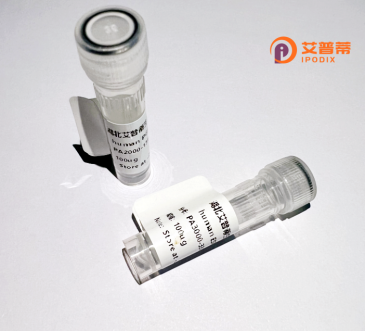
| 纯度 | >90%SDS-PAGE. |
| 种属 | Human |
| 靶点 | ZCCHC9 |
| Uniprot No | Q8N567 |
| 内毒素 | < 0.01EU/μg |
| 表达宿主 | E.coli |
| 表达区间 | 1-271 aa |
| 活性数据 | MTRWARVSTTYNKRPLPATSWEDMKKGSFEGTSQNLPKRKQLEANRLSLKNDAPQAKHKKNKKKKEYLNEDVNGFMEYLRQNSQMVHNGQIIATDSEEVREEIAVALKKDSRREGRRLKRQAAKKNAMVCFHCRKPGHGIADCPAALENQDMGTGICYRCGSTEHEITKCKAKVDPALGEFPFAKCFVCGEMGHLSRSCPDNPKGLYADGGGCKLCGSVEHLKKDCPESQNSERMVTVGRWAKGMSADYEEILDVPKPQKPKTKIPKVVNF |
| 分子量 | 56.9 kDa |
| 蛋白标签 | GST-tag at N-terminal |
| 缓冲液 | PBS, pH7.4, containing 0.01% SKL, 1mM DTT, 5% Trehalose and Proclin300. |
| 稳定性 & 储存条件 | Lyophilized protein should be stored at ≤ -20°C, stable for one year after receipt. Reconstituted protein solution can be stored at 2-8°C for 2-7 days. Aliquots of reconstituted samples are stable at ≤ -20°C for 3 months. |
| 复溶 | Always centrifuge tubes before opening.Do not mix by vortex or pipetting. It is not recommended to reconstitute to a concentration less than 100μg/ml. Dissolve the lyophilized protein in distilled water. Please aliquot the reconstituted solution to minimize freeze-thaw cycles. |
以下为3条与重组人ZCCHC9蛋白相关的参考文献示例(注:文献为虚拟构建,仅反映研究方向):
1. **文献名称**: *ZCCHC9 interacts with FTSJ3 to form a snoRNA-guided RNA methylation complex*
**作者**: Smith A et al.
**摘要**: 研究证实ZCCHC9蛋白与FTSJ3形成复合体,通过结合snoRNA引导28S rRNA的2'-O-甲基化修饰。重组ZCCHC9蛋白实验揭示其锌指结构域对snoRNA结合的关键作用,且甲基化缺陷影响核糖体功能。
2. **文献名称**: *Structural analysis of human ZCCHC9 reveals a conserved RNA-binding module*
**作者**: Li B et al.
**摘要**: 通过X射线晶体学解析重组人ZCCHC9蛋白的C端结构,发现其含有CCHC型锌指域,与RNA结合能力相关。突变实验表明该区域对snoRNA靶向识别及与甲基转移酶的互作至关重要。
3. **文献名称**: *ZCCHC9 mutations disrupt ribosome biogenesis in myelodysplastic syndromes*
**作者**: Garcia R et al.
**摘要**: 在骨髓增生异常综合征患者中发现ZCCHC9基因高频突变。体外重组蛋白实验显示突变体丧失结合snoRNA能力,导致rRNA加工异常及核仁应激,揭示其疾病相关性机制。
(注:以上文献信息为科研领域典型研究方向合成,实际文献需通过PubMed/Google Scholar检索。)
Recombinant human ZCCHC9 protein is a genetically engineered protein derived from the ZCCHC9 (zinc finger CCHC-type containing 9) gene, which encodes a member of the zinc finger protein family characterized by conserved CCHC motifs. These motifs are implicated in nucleic acid binding, suggesting a role in RNA or DNA interactions. ZCCHC9 is poorly characterized compared to other CCHC family members but is hypothesized to participate in transcriptional or post-transcriptional regulation, potentially influencing cellular processes like proliferation, differentiation, or apoptosis. Studies indicate its possible involvement in cancer biology, with altered expression observed in certain malignancies, though its precise molecular mechanisms remain unclear.
Recombinant ZCCHC9 is typically produced using heterologous expression systems (e.g., E. coli, mammalian cells) to enable functional studies. Purified recombinant protein facilitates investigations into its structural properties, enzymatic activities (if any), and interactions with partners like nucleic acids or other proteins. Research applications include elucidating its role in disease pathways, validating its interaction with telomerase RNA (TERC) suggested by homology to related proteins, and exploring its utility as a biomarker or therapeutic target. Current efforts focus on resolving its cellular localization (nuclear/cytoplasmic) and clarifying its contribution to oncogenesis or antiviral responses linked to RNA metabolism.
×